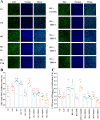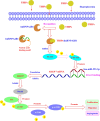Peptides based on the interface of hnRNPA2B1-transthyretin complex repress retinal angiogenesis in diabetic retinopathy
- PMID: 40253339
- PMCID: PMC12008863
- DOI: 10.1186/s12967-025-06437-y
Peptides based on the interface of hnRNPA2B1-transthyretin complex repress retinal angiogenesis in diabetic retinopathy
Abstract
Background: Heterogeneous nuclear ribonucleoprotein A2B1 (hnRNPA2B1) plays a vital role in angiogenesis, when its nucleic acid-binding domain is occupied by transthyretin (TTR), the neovascularization of human retinal microvascular endothelial cells (hRECs) is repressed under hyperglycemic conditions.
Methods: HnRNPA2B1-targeting peptides (THIPs) were designed based on the core fragments at the TTR-hnRNPA2B1 interface. Biacore, Langmuir equilibrium adsorption, and co-immunoprecipitation (co-IP) assays were performed to determine the association between the THIPs and hnRNPA2B1. Proliferation and DNA synthesis in hRECs were detected using CCK-8 and EdU assays. Transwell, wound healing, and tube formation assays were used to evaluate migratory and the angiogenic capacity of hRECs. Related RNA and protein expression levels were tested by quantitative PCR and western blot assays, respectively. Streptozotocin (STZ)-induced diabetic retinopathy (DR) model rats were intravitreally injected with 5 μL of AAV9 virus (1 × 1012 vg/mL) every 8 weeks, with sterile saline used as control. After 16 weeks, the retinas were extracted and subjected to Evans blue leakage and retinal trypsin digestion assays. Retinal paraffin sections were prepared and stained with hematoxylin and eosin (H&E) or subjected to immunohistochemical or immunofluorescence assays.
Results: Biacore, Langmuir equilibrium adsorption, and co-IP analyses demonstrated that the four designed THIPs specifically recognized hnRNPA2B1. CCK-8 and EdU labeling assays showed that the THIPs inhibited proliferation and DNA synthesis in hRECs under hyperglycemia. Transwell, wound healing and tube formation assays demonstrated that the THIPs inhibited the migratory and angiogenic capacity of hRECs. Quantitative PCR and western blot assays suggested that the THIPs exerted their effects via the STAT4/miR-223-3p/FBXW7 and the downstream Notch1/Akt/mTOR axes. In vivo studies using DR model rat revealed that the intravitreal administration of THIP-4 significantly mitigated retinal leakage, capillary decellularization, pericyte loss, fibrosis, and gliosis during DR progression.
Conclusion: Our findings demonstrated that under hyperglycemia, THIP-4 suppressed DR progression via the STAT4/miR-223-3p/FBXW7 and Notch1/Akt/mTOR axes both in vitro and in vivo. These results indicated that THIP-4 has strong potential for clinical application in DR and other angiogenesis associated diseases.
Keywords: DR rat model; Diabetic retinopathy; HnRNPA2B1; Retinal angiogenesis; THIPs.
© 2025. The Author(s).
Conflict of interest statement
Declarations. Ethics approval and consent to participate: The study was approved by the Ethics Committee of the Affiliated Wuxi People’s Hospital of Nanjing Medical University (2022-033, 18-Oct-2022) in China. Consent for publication: Not applicable. Competing interests: The authors declare no competing interests.
Figures









References
-
- Krastev E, Abanos S, Kovachev P, Tcharaktchiev D. Diabetes prevalence and duration data extracted from outpatient records representative for the Bulgarian population. Stud Health Technol Inform. 2023;305:230–3. - PubMed
MeSH terms
Substances
Grants and funding
LinkOut - more resources
Full Text Sources
Medical
Research Materials
Miscellaneous

